Barber J.R. Intermediate Mechanics of Materials
Подождите немного. Документ загружается.

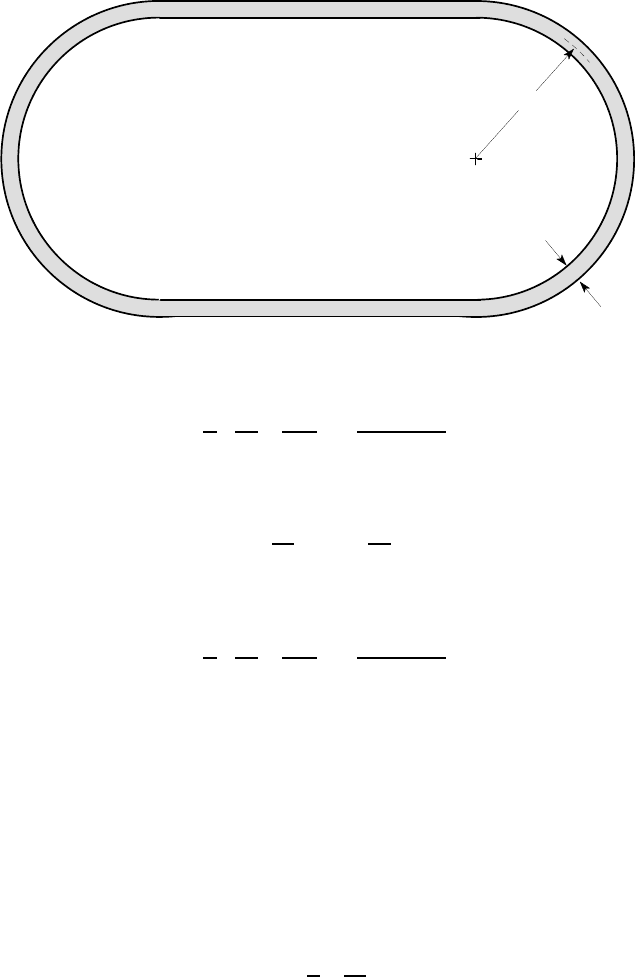
8.5 Strains and Displacements 405
a
t
internal pressure p
Figure 8.21: Cylindrical pressure vessel with hemispherical ends
and hence
u
r
=
a
E
pa
t
−
ν
pa
2t
=
pa
2
(2 −
ν
)
2tE
.
For the spherical ends, we find
σ
1
=
pa
2t
;
σ
2
=
pa
2t
and hence
u
r
=
a
E
pa
2t
−
ν
pa
2t
=
pa
2
(1 −
ν
)
2tE
.
Thus, the spherical ends have less radial displacement than the cylinder. The
deformed shape will be as shown in Figure 8.22. The predictions of the membrane
theory are shown as a solid line, but clearly there must again be a transition region,
shown dotted, in which bending stresses will be important.
More generally, the construction for R
2
in Figure 8.11 shows that this radius will
be continuous as long as there are no sudden changes in the tangent plane of the shell
(i.e. no kinks, as would occur for example at a cone/cylinder transition). Under these
conditions, equilibrium considerations show that the meridional stress
σ
1
will also
be continuous as long as the thickness remains constant. However, equation (8.2) can
be written
σ
2
= R
2
p
t
−
σ
1
R
1
, (8.6)
showing that there will generally be a discontinuity in
σ
2
, and hence in the radial
displacement u
r
, if R
1
is discontinuous, as is clearly the case at the transition from a
cylinder (R
1
= ∞) to a sphere. This discontinuity can be avoided by allowing a more
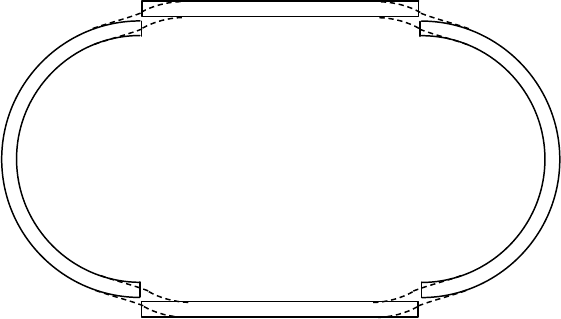
406 8 Membrane Stresses in Axisymmetric Shells
gradual transition in the radius R
1
. We shall return to this topic after introducing
methods for determining bending stresses in the next chapter.
Figure 8.22: Deformation under pressure of the vessel of Figure 8.21
8.6 Summary
Shells are strong, stiff, lightweight structures that in most cases can transmit applied
loads by in-plane membrane stresses (i.e. stresses which are uniform through the
thickness). By contrast, flat plates always experience bending under lateral loading
and are therefore relatively flexible and weak.
For axisymmetric shells, the meridional membrane stress can always be found by
making an appropriate transverse cut, drawing the resulting free-body diagram and
enforcing axial equilibrium. The circumferential stress can then be determined from
the membrane equilibrium equation (8.2).
Once the membrane stresses are known, the strains and hence radial displace-
ments can be calculated using Hooke’s law. The membrane theory of shells predicts
the occurrence of discontinuities in radial displacement wherever the loading or the
shell radius is discontinuous. In these regions, localized shell bending will occur and
higher stresses will be obtained. This topic is addressed in Chapter 9.
Further reading
W.B. Bickford (1998), Advanced Mechanics of Materials, Addison Wesley, Menlo
Park, CA, §§8.1–8.4.
A.H. Burr (1981), Mechanical Analysis and Design, Elsevier, New York, §§8.2–8.4.
R.D. Cook and W.C. Young (1985), Advanced Mechanics of Materials, Macmillan,
New York, §§6.1–6.4.
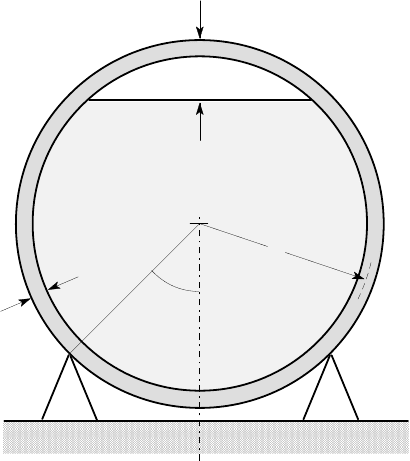
Problems 407
W. Fl¨ugge (1973) Stresses in Shells, Springer-Verlag, New York, 2nd edn., §2.2.
S.P. Timoshenko and S. Woinowsky-Krieger (1959) Theory of Plates and Shells,
McGraw-Hill, New York, 2nd edn., §§105–108.
A.C. Ugural and S.K. Fenster (1995), Advanced Strength and Applied Elasticity,
Prentice-Hall, Eaglewood Cliffs, NJ, 3rd edn., §§13.9–13.11.
Problems
Sections 8.1, 8.2
8.1. A spherical fuel oil tank of radius R sits on an annular ring support, as shown in
Figure P8.1. The oil density is
ρ
and the oil level is a distance bR from the crown of
the tank.
Figure P8.1
Find the meridional stress just above the support ring and hence find the value of
b for which this stress is numerically a maximum. The self-weight of the tank can be
neglected.
8.2. Figure P8.2 shows the cross section of an axisymmetric chemical process vessel
which is required to contain gas at a pressure of 1 MPa. The wall thickness is 10 mm
everywhere. The self-weight of the shell can be neglected.
bR
t
45
o
R
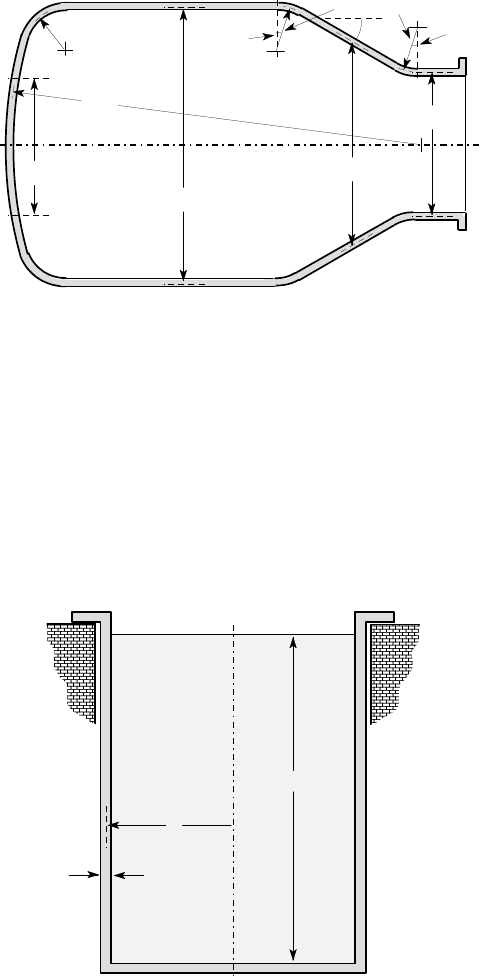
408 8 Membrane Stresses in Axisymmetric Shells
o
30
o
15
o
15
A
D
E
A
B
C
300 mm
300 mm
3 m
2 m
1 m
1 m
1.5 m
Figure P8.2
For each of the points A, B, C, D, E:-
(i) Find the radii of curvature R
1
,R
2
, using the sign convention of §8.2.2.
(ii) Find the membrane stresses
σ
1
,
σ
2
.
8.3. A cylindrical tank of height h, radius a and wall thickness t is supported from
the top, as shown in Figure P8.3. It is just full of oil of density
ρ
. Find the membrane
stresses (i) at the top of the tank and (ii) just above the flat bottom of the tank. Neglect
the self-weight of the tank.
t
h
a
Figure P8.3
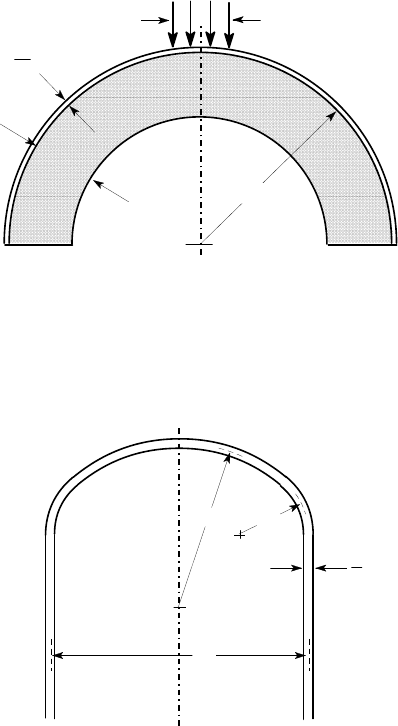
Problems 409
8.4. A lightweight crash helmet consists of a 6 in radius hemispherical aluminium
shell of wall thickness 3/32 in, padded on the inside with a 2 in layer of expanded
polystyrene. In an impact, a maximum force of 2000 lbs is exerted on the helmet,
uniformly distributed over a circular region of diameter 2 in as shown in Figure P8.4.
Assuming the balancing force from the padding to consist of a uniform pressure over
the entire hemispherical internal surface, find the maximum shear stress in the shell.
Figure P8.4
8.5. Figure P8.5 shows a design for the end of a cylindrical tank which is to contain
air at 250 psi. Find the maximum tensile membrane stress in the tank.
1
4
20
78
50
thick
all dimensions in inches
Figure P8.5
8.6. A hemispherical dome is partially submerged in water of density
ρ
, as shown in
Figure P8.6. Find the membrane stresses at the point A, defined by the angle
φ
. You
2 in. diameter
loaded region
2 in.
3
32
in.
6 in.
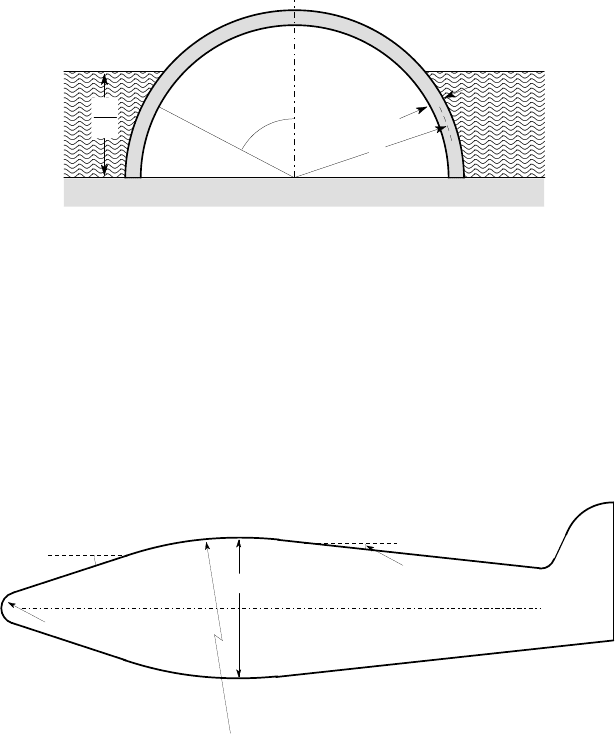
410 8 Membrane Stresses in Axisymmetric Shells
can assume that the pressure inside the dome and above the water surface is atmo-
spheric pressure p
0
and that the stresses due to self-weight of the shell are negligible.
R
t
A
φ
2R
3
Figure P8.6
8.7. Figure P8.7 shows an aircraft fuselage, which can be assumed to be approxi-
mately axisymmetric. It comprises two conical segments of semi-angle 18
o
and 6
o
respectively, smoothly connected to a spherical nose and an intermediate segment of
radius R
1
=15 m and maximum diameter 6 m.
Estimate the maximum membrane stress and the maximum shear stress in the
fuselage when the cabin pressure is 100 kPa and the outside air pressure is 30 kPa.
The thickness of the shell is 4 mm everywhere.
6
o
18
o
6 m
1.2 m radius
15 m radius
Figure P8.7
8.8*. Figure P8.8 shows the cross section of a toroidal pressure vessel, the toroid
being essentially a tube of radius a whose centreline is a circle of radius b. The wall
thickness is t(≪a,b) and the vessel contains gas at pressure p.
Neglecting the weight of the gas and the shell, find the membrane stresses at a
general point Q defined by the coordinate
φ
.

Problems 411
t
Q
b
a
φ
Figure P8.8
8.9. The thin-walled sphere in Figure P8.9 has a mean radius a and wall thickness t.
It is compressed by equal and opposite forces F on a diameter. There is no internal
pressure. Find the membrane stresses at A.
t
a
A
F
F
φ
Figure P8.9
8.10. The thin-walled pressure vessel of Figure P8.10 is of uniform wall thickness t
and consists of a conical section of semi-angle 30
o
and a spherical section of mean
radius a such that slope and radius are continuous at the transition. It is subjected to
an external pressure p
0
.
Find the magnitude and location of the maximum values of the two membrane
stresses
σ
1
,
σ
2
and of the stress difference |
σ
1
−
σ
2
|.
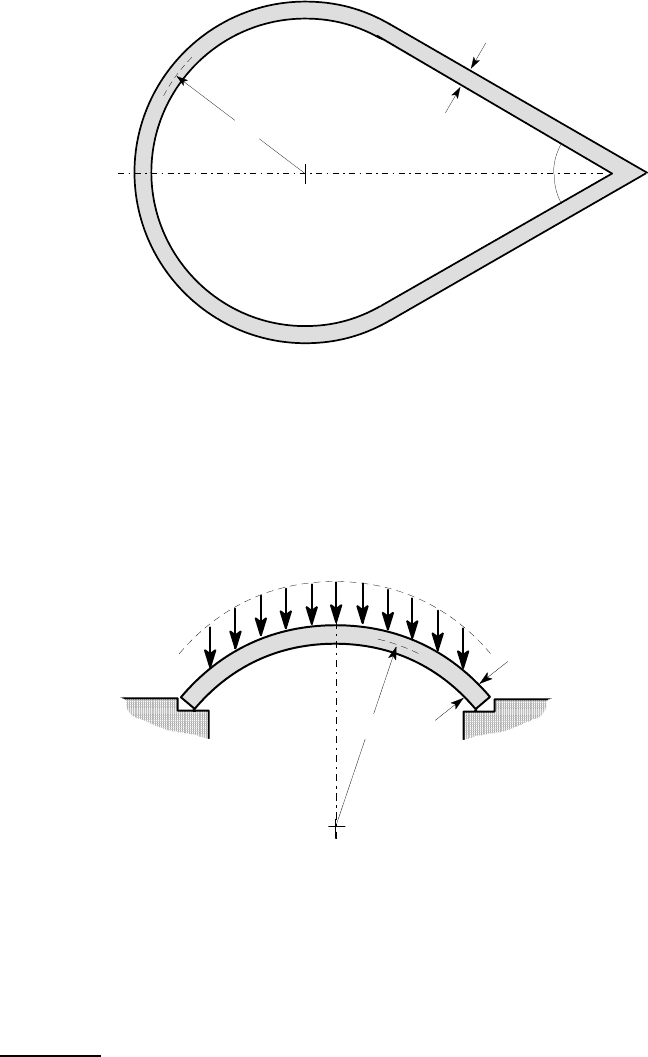
412 8 Membrane Stresses in Axisymmetric Shells
30
o
30
o
t
a
Figure P8.10
8.11. Snow accumulation on the spherical roof shell of Figure P8.11 causes a loading
of w
0
per unit projected
6
area. The shell has mean radius a and thickness t. Find the
membrane stresses in the shell as functions of the polar angle
φ
, neglecting the effect
of shell self-weight.
Figure P8.11
Sections 8.3, 8.4
8.12. Figure P8.12 shows a proposed design for the upper section of an axisymmetric
cooling tower, which is to be made of concrete of density 2300 kg/m
3
.
6
In other words, the vertical thickness of the snow layer is uniform.
a
φ
w
0
t
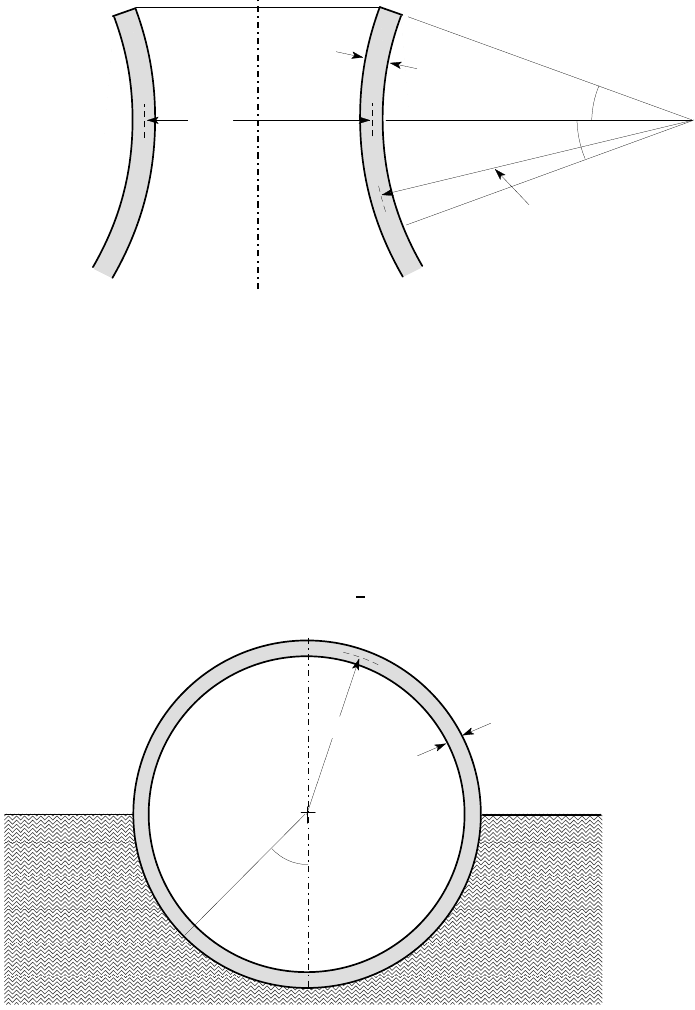
Problems 413
o
20
o
20
t
A
B
15 m radius
15 m
Figure P8.12
Find the minimum value of the shell thickness t if the tower must be capable
of sustaining an internal pressure 2kPa at A and 5kPa at B without inducing tensile
membrane stresses at these points. With your choice of t, do you expect there to be
tensile stresses elsewhere in the tower and if so where?
8.13. Figure P8.13 shows a closed spherical container of mean radius a whose wall
thickness t (t ≪a) is chosen to cause it to float just half submerged in a fluid of
density
ρ
. Develop expressions for the membrane stresses in the submerged portion
of the sphere as a function of
φ
. There is no internal pressure.
Note: The volume of a sphere of radius a is
4
3
π
a
3
, whilst its surface area is 4
π
a
2
.
Figure P8.13
a
t
φ
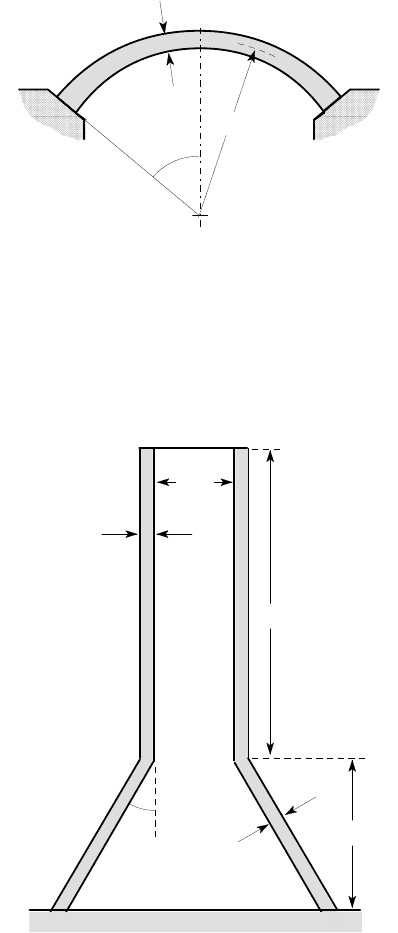
414 8 Membrane Stresses in Axisymmetric Shells
8.14. Figure P8.14 shows a spherical roof shell whose thickness t varies with
φ
, being
given by
t = t
0
(4 −3 cos
φ
) ,
where t
0
is a constant.
Figure P8.14
Calculate the membrane stresses in the roof due to self-weight alone, if it is made
from a material of density
ρ
. Compare the values at
φ
= 0 and 45
o
and comment on
your results.
8.15. Figure P8.15 shows the cross section of a concrete chimney, loaded only by its
own weight. The density of concrete is 2300 kg/m
3
. Find the membrane stresses at
the base of the chimney.
100 mm
100 mm
4 m
8 m
2 m
30
o
Figure P8.15
a
φ
t
45
o
